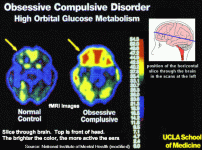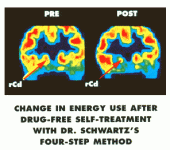David Baxter PhD
Late Founder
Those Darned Unwanted Thoughts!
by Robert L. Leahy, Psychology Today
June 1, 2009
Have you ever felt plagued by thoughts and images that you just couldn't stand? Perhaps it's the nagging thought, "I made a mistake" or "I think I have cancer" or "I'm going to lose control." These thoughts seem to intrude on your mind and you try to block them out. You think about your thought and you say (to yourself) something like the following:
You are battling your mind. You think, "Normal people don't have these thoughts". You are afraid of the thought, embarrassed, and you think that the thought predicts something about the future. Maybe the thought means you are dangerous or that you will be punished by God.
Welcome to the world of "intrusive thoughts". Cognitive therapy can help you. Your problem is not that you are having intrusive thoughts. Your problem is how you are evaluating them, how you are trying to suppress them, and how you avoid situations that evoke them. The problem is not the thought??it's what you try to do about the thought.
Thinking about your thoughts
Three rules are important.
Thoughts and reality are not the same. If they were, you'd be rich. Try to think about a pot of gold. Think about it all day. Wish for it. Pray for it. At the end of the day, all you will have are a lot of thoughts. You can't take your thoughts to the bank.
Your idea that thoughts=reality is what Jack Rachman of the University of British Columbia called "thought-action fusion". People with obsessive compulsive disorder think, "If I think I will lose control, I will" or "If I think that Satan might possess me, he will". Sorry, it's just a thought.
Also, thought suppression doesn't work. Perhaps someone told you, "Snap a rubber band on your wrist every time you have that (BAD) thought". It doesn't work. The thought keeps coming back. Leon Tolstoy described a game he played when he was a kid in Russia. They would stand in a corner and try not to think about a white bear. Years later, Harvard psychologist Dan Wegner showed that people instructed not to think about a white bear were more likely to think about white bears. Thought suppression leads to thought rebound.
Cognitive therapists have been interested in how we evaluate our intrusive thoughts. For example, Canadian psychologists Christine Purdon and David Clark have reviewed the research on intrusive thoughts. They find that evaluations and thought-control strategies for intrusive thoughts and images are a core feature of all of the anxiety disorders. People with OCD try to suppress and neutralize thoughts and images??often with compulsive rituals. People with social anxiety disorder treat their intrusive thoughts about "appearing anxious" as the equivalent of being humiliated. And people with PTSD treat their intrusive images and sensations as evidence that the trauma is happening now. It's like we are running away from our minds.
It's like trying to run away from your hips. No matter how fast you run, they're always there.
Robert L. Leahy, Ph.D., is the author of Anxiety Free, The Worry Cure, and Beat the Blues. He is Clinical Professor of Psychology at Weill-Cornell Medical School and Director of the American Institute for Cognitive Therapy.
by Robert L. Leahy, Psychology Today
June 1, 2009
Have you ever felt plagued by thoughts and images that you just couldn't stand? Perhaps it's the nagging thought, "I made a mistake" or "I think I have cancer" or "I'm going to lose control." These thoughts seem to intrude on your mind and you try to block them out. You think about your thought and you say (to yourself) something like the following:
- I'm having that thought again.
- What's wrong with me that I'm thinking that?
- It must mean something about me.
- I have to do something---make sure it doesn't become a reality
- I have to stop having that thought.
You are battling your mind. You think, "Normal people don't have these thoughts". You are afraid of the thought, embarrassed, and you think that the thought predicts something about the future. Maybe the thought means you are dangerous or that you will be punished by God.
Welcome to the world of "intrusive thoughts". Cognitive therapy can help you. Your problem is not that you are having intrusive thoughts. Your problem is how you are evaluating them, how you are trying to suppress them, and how you avoid situations that evoke them. The problem is not the thought??it's what you try to do about the thought.
Thinking about your thoughts
Three rules are important.
- Everyone has crazy and disgusting thoughts
- Thoughts are not the same thing as reality
- Thought-suppression doesn't work.
Thoughts and reality are not the same. If they were, you'd be rich. Try to think about a pot of gold. Think about it all day. Wish for it. Pray for it. At the end of the day, all you will have are a lot of thoughts. You can't take your thoughts to the bank.
Your idea that thoughts=reality is what Jack Rachman of the University of British Columbia called "thought-action fusion". People with obsessive compulsive disorder think, "If I think I will lose control, I will" or "If I think that Satan might possess me, he will". Sorry, it's just a thought.
Also, thought suppression doesn't work. Perhaps someone told you, "Snap a rubber band on your wrist every time you have that (BAD) thought". It doesn't work. The thought keeps coming back. Leon Tolstoy described a game he played when he was a kid in Russia. They would stand in a corner and try not to think about a white bear. Years later, Harvard psychologist Dan Wegner showed that people instructed not to think about a white bear were more likely to think about white bears. Thought suppression leads to thought rebound.
Cognitive therapists have been interested in how we evaluate our intrusive thoughts. For example, Canadian psychologists Christine Purdon and David Clark have reviewed the research on intrusive thoughts. They find that evaluations and thought-control strategies for intrusive thoughts and images are a core feature of all of the anxiety disorders. People with OCD try to suppress and neutralize thoughts and images??often with compulsive rituals. People with social anxiety disorder treat their intrusive thoughts about "appearing anxious" as the equivalent of being humiliated. And people with PTSD treat their intrusive images and sensations as evidence that the trauma is happening now. It's like we are running away from our minds.
It's like trying to run away from your hips. No matter how fast you run, they're always there.
Robert L. Leahy, Ph.D., is the author of Anxiety Free, The Worry Cure, and Beat the Blues. He is Clinical Professor of Psychology at Weill-Cornell Medical School and Director of the American Institute for Cognitive Therapy.


